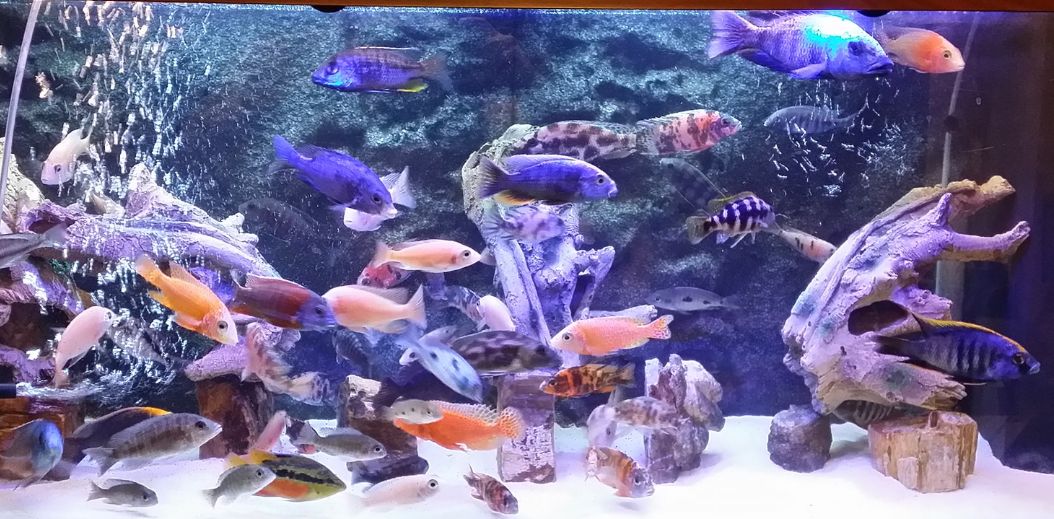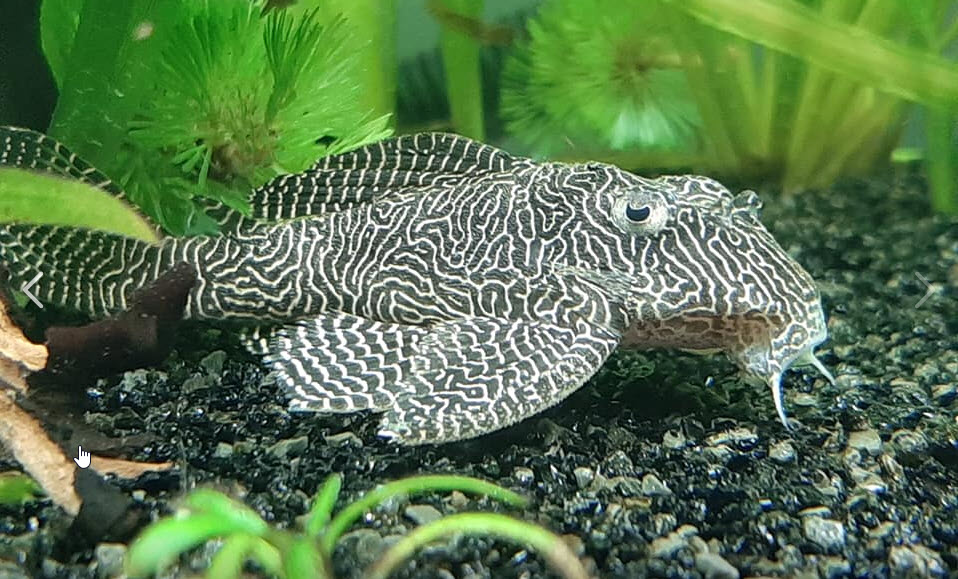
There are two types of nematodes or roundworms which are common pathogens on aquarium fish: capillaria and camallanus. These two worms are covered in separate sections with links below.
Well-maintained fish may be infected without exhibiting any symptoms at all, and nematodes worms are commonly found among wild fish without any obvious link between infection and mortality. But negative environmental pressures such as high bacteria count in the water will reduce the immune response of infected aquarium fish, making it easier for the worms to multiply and cause damage to their host fish.
These worms are relatively large. So a large fish can have an infestation with no big problem. But a small fish like a guppy will have a huge problem. These worms are very serious killers of small livebearers like guppies.

Treatment
One must treat nematodes by adding a dewormer to the food. It is a myth that adding medication to the water of the aquarium will cure nematodes. This myth is propagated by medication manufacturers who recognize that their profit will be much greater if one adds large amounts of medication to the water in the aquarium.
Fenbendazole (Panacur and Safeguard for dogs, and several livestock dewormers) is the most effective medication. It is the medication of choice for nematodes by public aquariums (Hadfield, 2011).
Levamisole is also an effective medication if mixed into the food. Fritz Expel-P is levamisole. Levamisole can also be purchased at Amazon, subaquaria .com and Valleyvet .com. Some eBay sellers supposedly sell bogus products, look for cattle products such as Agrilabs Prohibit Soluble Drench Powder and DURVET Levamed Soluble Drench Powder Dewormer.

Other medications supposedly effective against nematodes are Pyrantel Pamoate, Flubendazole (Kusuri Wormer Plus), Ivermectin and Piperazine. In some countries this is all that are available to aquarium hobbyists. All are mixed into the food at roughly a 1 to 5% level (an amount equal to a barley grain to two tablespoons of food).
Note that the cautions about deaths of snails, shrimp and invertebrates is very dose dependent. Copper and Fenbendazole are often used with no snail deaths because the dosage isn’t high enough. Conversely using a very high dosage of fenbendazole can possibly kill shrimp. And Levamisole is safe for everything except nematodes and snails. Praziquantel is safe with everything except planaria and flukes. But copper WILL kill shrimp at any reasonable dosage.
Medications do not kill the worms, they only paralyze the barbed jaws that the roundworms hold onto the gut with. So, the detached but live worms get pushed out of the gut and into the aquarium (which the aquarist will see when the pink or red worms emerge and detach from the anus). Within 24 hours of medicating the substrate should be thoroughly cleaned to remove the worms.
The best situation is to transfer the fish to a bare bottom hospital tank. that way the worms which are paralyzed can be easily seen and vacuumed up.

All the medications treat only relatively narrow classes of organisms. This is opposed to things such as disinfectants which kill any living cell they can penetrate. This make these medications very safe. All are also approved by the FDA internally in humans. While not a 100% guarantee, this would indicate they are probably safe in fish.
It is easy to make medicated food. Heat 1/4 cup water (two ounces or 58 milliliters, not a lot) in the microwave. Then blend seven grams of plain animal derived gelatin (Knox gelatin, one packet) into the hot solution with vigorous stirring. Take two tablespoons of dry commercial fish food (pellets or flake) and mix it with just a little of the hot water/ gelatin mixture. Add hot water/gelatin until you get a paste like consistency. If it gets too watery just add more food. To get gel food to float simply mix in a little whipped cream at this point.
Then add roughly 1/16 teaspoon (a 1% to 2% addition, an amount equal to a barley grain) of the medication to the mud. Mix and mash the whole mass thoroughly. Spread it out into a pancake about 1/8th inch (3 mm) thick on a plastic film or a plate. Then put in the refrigerator. If you plan on keeping it for more than two weeks put it in a small plastic bag and freeze.
Feed fish with Fenbendazole or levamisole in the food for once a week for three months in order to eliminate nematodes. Note while the fish won’t eat it like they normally do, they typically will eat some if you just leave it in the tank.

Mode of Medication Application
Many people say only levamisole is effective against nematodes. They are incorrect. Some authors have said that Levamisole works great when added to the water. They say that Levamisole is absorbed through the skin and the gills. This is simply not true. The Levamisole molecules are far too large to be absorbed through either the skin or the gills. It just is impossible.
Levamisole is unique in that it is one of the very few medications which is actually soluble in the water. So fish with red camallanus worms hanging out of their anus will have the worms hanging out paralyzed. The worms fall out of the anus and the hobbyists thinks the fish is cured. But ONLY the worms hanging out into the water were paralyzed. The worms still inside the fish are not affected.
Internal fish diseases such as camallanus can ONLY be truly treated in the food. Many believe (and the instructions on the dewormers say!) that fish medications need to be added to the water. They are simply incorrect. This controversial topic is covered in the following link:
12.5. Fish Don’t Drink
Ineffective Medications
Praziquantel only treats tapeworms and flukes. So Praziquantel does not work against nematodes (camallanus and capillaria).
There are a host of other medications such as metronidazole which are claimed to be effective against nematodes. This is all just marketing hype to make money. It is classic “snake oil” claims.
Each of the two types of roundworm or nematodes is covered in the following links:
10.12.1. Camallanus
10.12.2. Capillaria
.
Return to Diseases Menu
.
Aquarium Science Website
The chapters shown below or on the right side in maroon lead to close to 400 articles on all aspects of keeping a freshwater aquarium. These articles have NO links to profit making sites and are thus unbiased in their recommendations, unlike all the for-profit sites you will find with Google. Bookmark and browse!
.

Dave says
In reply to Ben Z … Haven’t run across anything on either of your questions.
Ben z says
Diana walstad wrote in an article on her website that flubendazole in the water will kill defecated nematode eggs too (at least for camallanus and capillaries spp.) have u come across any hard research on that?
And erm… what about nematodes of the strongyloides genus (did I spell that right…?) is there any effective treatment that you know of?